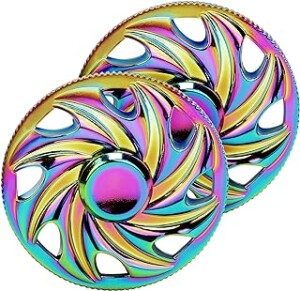How do you distinguish stimming in autism from the repetitive movements of OCD, especially OCD in someone without autism?
Or are they essentially the same, and the only “difference” is whether or not someone is autistic?
Let’s examine this fascinating comparison.
Obsessive compulsive disorder (OCD) and autistic stimming are often misunderstood and confused due to their outwardly similar behaviors.
However, the underlying causes, functions and manifestations of these behaviors differ significantly.
Definitions and Characteristics
OCD is a mental health condition characterized by intrusive, unwanted thoughts (obsessions) and repetitive behaviors (compulsions) that an individual feels driven to perform in response to these obsessions.
OCD behaviors are typically performed to alleviate anxiety or prevent a feared event or situation.
In its severest form, it can be disabling and impair quality of life.
I once read of a woman whose OCD made her spend inordinate amounts of time cleaning her car, inspecting it for dirt, and fearing she’d get sick if she drove it.
Common obsessions include fears of contamination, harm or a need for symmetry, while common compulsions include excessive cleaning, washing one’s hands, checking (e.g., if the stove was left on), counting or arranging items.
Autistic stimming, or self-stimulatory behavior, is a common characteristic of Autism Spectrum Disorder (ASD).
Stimming involves repetitive movements, sounds, behaviors or thoughts that are used by Autistics to regulate sensory input, express emotions, cope with overwhelming or stressful situations, or – for the sheer joy of it.
Examples of stimming include hand-flapping, rocking, spinning, repeating phrases or using a “fidget toy.”

Spinner fidgets
Stimming is generally seen as a way for autistic individuals to self-soothe or manage sensory overload.
I stim with my hair. I love pressing wads of it to my face to feel its unique texture as well as take in its sweet, syrupy scent. I swear, there are times my hair smells like fresh funnel cake!
Underlying Causes
The underlying causes of OCD and autistic stimming are fundamentally different.
OCD. The root of OCD lies in anxiety and the need to mitigate it.
Obsessions trigger significant distress, leading to compulsions aimed at reducing this anxiety.
Neurobiological factors, genetics and environmental influences all play a role in the development of OCD.
The compulsion is directly tied to the obsession, creating a cycle that reinforces the behavior.
Autistic stimming. Stimming is primarily related to sensory processing differences in autistic individuals.
These behaviors help in managing sensory input and emotional responses.
Unlike OCD, stimming is not necessarily driven by anxiety or a need to prevent a feared event, but rather, serves as a mechanism for self-regulation and expression, plus in some cases, a source of joy (think: my hair!).
Triggers and Functions in OCD Behavior
The triggers and functions of behaviors in OCD and autistic stimming vary greatly.
OCD behaviors are triggered by specific obsessions or intrusive thoughts.
For example, a fear of germs might trigger compulsive hand-washing.
A fear of a motor vehicle accident might trigger repeated hitting of the brakes to see if the seatbelt locks.
Ten consecutive locks may not be enough to convince the OCD driver; they may need to go to 20 or even 50 before they’re satisfied the brakes lock the seatbelt.
The main function of compulsions in OCD is to reduce anxiety or prevent a perceived negative outcome.
The relief, however, is temporary, and the cycle of obsessions and compulsions continues.
Triggers and Functions in Autistic Stimming
Stimming can be triggered by a variety of factors, including sensory overload, emotional stress, excitement or even boredom.
Stimming in autism can also occur subconsciously. I speak from experience. I’ll suddenly realize that I’ve been clicking my teeth together, or gently chewing on my tongue, all afternoon long.
Stimming is often a response to the need for sensory input or a way to express emotions.
When I brought a big squishy ball to a social meetup for Autistics, one of the women immediately took to it and delighted in repeatedly squeezing it while having conversation.
Stimming helps autistic people manage their sensory environment, reduce stress and communicate feelings.
It can be soothing and provide a sense of control in overwhelming situations.
An Autistic will repeatedly spin their spinner gadget – not because they think something bad will happen if they don’t, but because it’s soothing, calming, self-regulating and perhaps just doggone cool to watch the thing spin.
Manifestations of OCD Behavior
The manifestations of OCD behaviors and autistic stimming also exhibit key differences.
OCD behaviors are often rigid and must be performed in a specific way to alleviate anxiety.
Any deviation from the ritual can cause significant distress and may result in the need to start over.
For example, tapping one’s leg must be done 20 times, in sets of four, to prevent a perceived misfortune.
If a phone ringing makes the person lose count – they aren’t sure if the last set was done four or five times, they must start all over.
Those with OCD are typically distressed by their obsessions and compulsions, which may include intrusive thoughts, such as drowning their beloved cat in the toilet. They hate when these thoughts barge into their mind.
They often recognize that their thoughts and behaviors are irrational but feel powerless to stop them.
This distress can lead to avoidance behaviors, where individuals avoid situations that trigger their obsessions.
Manifestations of Autistic Stimming
While stimming behaviors can be repetitive, they are not necessarily rigid or specific in the way OCD compulsions are.
The behaviors can vary widely and may change over time or depending on the context.
Many Autists and their supporters view stimming as a natural and integral part of their identity.
Unlike OCD, stimming is not usually a source of significant distress for the individual, although it may be misunderstood or stigmatized by others.
Some forms of stimming can be detrimental, though, such as skin picking (infection, unsightliness) or cuticle chewing (infection, unsightliness).
Stimming in the form of repetitive thoughts, unlike in OCD, are quite welcome in the autistic person.
For example, an autistic man I know cracks his knuckles. All day long, he thinks to himself, “I cracked it,” “He cracked it,” “You cracked it,” and “It’s been cracked.”
He told me if he got a dime for every time he thought these lines, he’d have a trip to Hawaii. He enjoys these thoughts; they are not intrusive.
Social and Psychological Implications
The social and psychological implications of OCD and autistic stimming differ, impacting individuals’ lives in unique ways.
OCD can significantly interfere with daily functioning, relationships and quality of life.
The compulsions can be time-consuming and may lead to avoidance of social situations, impacting social interactions and opportunities.
The chronic anxiety and distress associated with OCD can lead to depression and other mental health issues.
The constant battle with obsessions and compulsions can be exhausting and debilitating.
Stimming in autism may be misunderstood or judged by others, leading to social stigma and exclusion.
However, stimming itself does not typically interfere with social interactions unless it’s perceived negatively by others.
For many on the Spectrum, stimming is a positive and necessary coping mechanism.
Efforts to suppress or eliminate stimming can lead to increased stress and anxiety.
When I temporarily lost my sense of smell from COVID-19, the thought of never again being able to smell my hair was unthinkable.
When my ability to smell its dynamic scent returned, I squealed and was ecstatic!
Acceptance and understanding of stimming is extremely important, though many Autists continue to suppress stimming when around neurotypicals.
A Final Note
An Autistic can also, by coincidence, have OCD. I’ve had bouts of OCD myself, but only mild.
As one who is both on the Autism Spectrum and has had a little OCD, I can definitely tell the difference.
Because there IS a difference – a big difference!
 Lorra Garrick has been covering medical and fitness topics for many years, having written thousands of articles for print magazines and websites, including as a ghostwriter. She’s also a former ACE-certified personal trainer. In 2022 she received a diagnosis of Level 1 Autism Spectrum Disorder and subsequently has developed an intense interest in ASD.
Lorra Garrick has been covering medical and fitness topics for many years, having written thousands of articles for print magazines and websites, including as a ghostwriter. She’s also a former ACE-certified personal trainer. In 2022 she received a diagnosis of Level 1 Autism Spectrum Disorder and subsequently has developed an intense interest in ASD.
.















